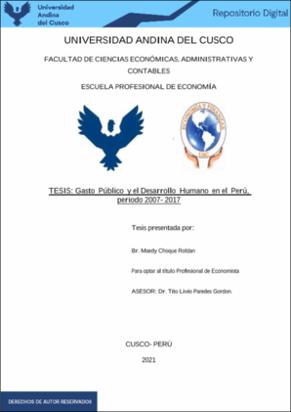| dc.contributor.advisor | Paredes Gordón, Tito Livio | |
| dc.contributor.author | Choque Roldan, Maedy | |
| dc.date.accessioned | 2022-03-30T17:43:34Z | |
| dc.date.available | 2022-03-30T17:43:34Z | |
| dc.date.issued | 2021-10-25 | |
| dc.identifier.uri | https://hdl.handle.net/20.500.12557/4487 | |
| dc.description.abstract | La investigación tuvo como objetivo general determinar la relación entre el gasto públicoy el desarrollo humano en el Perú, periodo 2007-2017, y describir el comportamiento degasto público y el desarrollo humano, para lo cual se recopilaron los datos de gastopúblico, así como del Índice de Desarrollo Humano. Respecto a la metodología, la
presente investigación fue de tipo analítico, correlacional y científico, con enfoquecuantitativo y diseño no experimental- longitudinal, los resultados hallados mostraron
que: Referente al gasto corriente en el periodo 2007–2017, este siguió una tendenciacreciente; con un incrementó de 161%, pasando de S/ 36650 millones en el 2007 a S/95658 millones para el 2017, teniendo un crecimiento anual promedio de 10.1%; los
gastos de capital en este periodo siguieron una tendencia creciente, incrementándose en247%, pasando de S/ 9884 millones en el 2007 a S/ 34326 millones para el 2017, teniendoun crecimiento anual promedio de 14.4%. El servicio a la deuda en el mismo periodo nosiguió ninguna tendencia, teniendo los datos muy dispersos. A pesar de esto se apreciaque para el año 2017 el servicio a la deuda se incrementó en 9%, pasando de S/ 11422millones*en el 2007 a S/ 12487 millones*para el 2017, teniendo un crecimiento anua
promedio de 1.7%, siendo esta la tasa*de*crecimiento*más baja en comparación a las
otras categorías del gasto. Para la variable gasto público general en el periodo en estudio,
se halló que este sigue una tendencia creciente, incrementándose en 146%, pasando de S/57956 millones en el 2007 a S/ 142472 millones para el 2017, teniendo un crecimiento
anual promedio de 9.5%. El Índice*de Desarrollo*Humano*para el periodo*en estudiosiguió una tendencia creciente, incrementándose en 5%, pasando de 0.71 en el 2007 a0.75 para el 2017, teniendo un crecimiento anual promedio de 0.5%. Finalmente, sedeterminó*que existe una relación significativa entre el Gasto público y el Índice deDesarrollo Humano con un nivel de confianza del 95%. El coeficiente*de correlación (r= 0.9) señala que la correlación*es positiva*y fuerte, aceptando la hipótesis especificageneral propuesta en esta investigación, la cual plantea: Existe una relación*directa entreel gasto público y el desarrollo*humano*en el*Perú, periodo 2007- 2017. | es_PE |
| dc.description.abstract | The present had the general objective of determining the relationship between public
spending and human development in Peru, period 2007-2017, and describing the behavior
of public spending and human development, for which data on public spending was
collected, as well as the Human Development Index. Regarding the methodology, this
research was analytical, correlational and scientific, with a quantitative approach and a
non-experimental-longitudinal design. The results found showed that: Regarding current
expenditure in the 2007–2017 period, this followed an increasing trend; with an increase
of 161%, going from S / 36.650 million in 2007 to S / 95.658 million for 2017, having an
average annual growth of 10.1%; Capital expenditures in this period followed a growing
trend, increasing by 247%, from S / 9.884 million in 2007 to S / 34.326 million for 2017,
with an average annual growth of 14.4%. Debt service in the same period did not follow
any trend, having widely dispersed data. Despite this, it can be seen that for the year 2017
the debt service increased by 9%, going from S / 11.422 million *in 2007 to S / 12.487
million*for 2017, having an average annual growth of 1.7%, this being the lowest * rate
*of *growth compared to other spending categories. For the variable general public
spending in the period under study, it was found that this continues an increasing trend,
increasing by 146%, going from S / 57.956 million in 2007 to S / 142.472 million for
2017, having an average annual growth of 9.5%. The Human Development *Index *for
the period*under study followed an increasing trend, increasing by 5%, going from 0.71
in 2007 to 0.75 for 2017, having an average annual growth of 0.5%. Finally, it was
determined*that there is a significant relationship between public spending and the
Human Development Index with a confidence level of 95%. The correlation coefficient
*(r = 0.9) indicates that the correlation*is positive*and strong, accepting the specific
general hypothesis proposed in this research, which states: There is a*direct relationship
between public spending and*human*development in*Peru, period 2007-2017. | en_US |
| dc.format | application/pdf | es_PE |
| dc.language.iso | spa | es_PE |
| dc.publisher | Universidad Andina del Cusco | es_PE |
| dc.rights | info:eu-repo/semantics/openAccess | es_PE |
| dc.rights.uri | https://creativecommons.org/licenses/by-nc-nd/4.0/ | es_PE |
| dc.subject | Gasto público | es_PE |
| dc.subject | Desarrollo humano | es_PE |
| dc.title | Gasto Público y el Desarrollo Humano en el Perú, periodo 2007- 2017 | es_PE |
| dc.type | info:eu-repo/semantics/bachelorThesis | es_PE |
| thesis.degree.name | Economista | es_PE |
| thesis.degree.grantor | Universidad Andina del Cusco. Facultad de Ciencias Económicas, Administrativas y Contables | es_PE |
| thesis.degree.discipline | Economía | es_PE |
| dc.publisher.country | PE | es_PE |
| dc.subject.ocde | https://purl.org/pe-repo/ocde/ford#5.02.01 | es_PE |
| renati.advisor.dni | 23800907 | |
| renati.advisor.orcid | https://orcid.org/0000-0001-6024-8209 | es_PE |
| renati.author.dni | 72950341 | |
| renati.discipline | 311016 | es_PE |
| renati.juror | Miranda Acuña, Margarita | |
| renati.juror | Vasquez Tevez, Manuel | |
| renati.juror | Beizaga Ramirez, Walter Claudio | |
| renati.juror | Castro Prieto Ayala, Delio Alex | |
| renati.level | https://purl.org/pe-repo/renati/level#tituloProfesional | es_PE |
| renati.type | https://purl.org/pe-repo/renati/type#tesis | es_PE |


